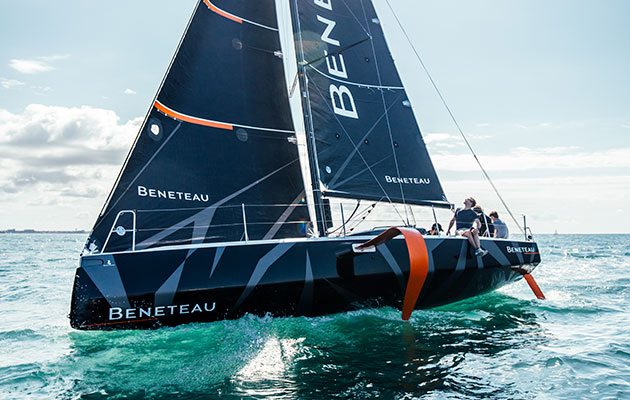Production of Figaro
Beneteau is going ahead with full-scale production of the world’s first foiling monohull – the Figaro 3.
Photography by Beneteau/Jean-Baptise d'Enquin
01 October 2017
Advertisement
Having announced late last year that it was building a foiling monohull, the Figaro 3, to replace the Figaro 2, Bénéteau has now announced construction has started on the first hulls, which will be delivered at the end of next year.
Just last month the company trialled the Figaro 3 protoype off the West coast of France. Based on that the Group has now indicated it will push ahead with the revolutionary design.
“We’re beginning to produce hulls and decks from mid-September,” confirms Eric Ingouf, head of the Figaro 3 programme at Bénéteau. “All the boats manufactured between September 2017 and December 2018 will only be delivered to their owners at the end of 2018 in the name of sporting equity with a view to participation in La Solitaire-URGO Le Figaro.”
Leading French design firm VPLP has created a contemporary looking race boat, but with novel looking foils designed to replace the traditional weighty ballast tanks used on past Figaro models. Described as “asymmetric tip foils”, they work by creating side force to supplement the skinny keel and reduce leeway while causing minimal drag. An important factor is also that they are able to retract manually within the boat’s maximum beam.
Advertisement
The foils could deliver a major performance boost – a Figaro 3 with foils working is expected to be up to 15 percent faster than its predecessor. More righting moment for less weight means that in general you have a much more powerful boat.
The foils are also described as innovative both in terms of geometry and manufacturing method. Designer Vincent Lauriot Prévost says: “The foam manufacturing process developed by the Carboman Group seems to us perfectly suited to the Figaro 3. Structural resistance, compliance with weight specifications and geometry go beyond our expectations. It is a fine example of collaboration between the builder, the client and the architect.”
Launched at the end of July in Saint-Gilles-Croix-de-Vie on France’s Atlantic coast, the prototype for the Figaro 3 required 3,000 man-hours to build at the Bénéteau site inCheviré, and since has since been undergoing intensive testing.
Managers from the Bénéteau yard, naval architects, members of the Mer Forte design office and representatives of the Figaro class have all been aboard in various conditions to trial the 9.75-metre design.
The sea-trials ended in mid-September, enabling the team to make the most of one last week of strong winds to definitively validate a boat that represents a significant technological breakthrough.
“The feedback is very positive. The results are in line with what the naval architect envisaged: the foils provide both additional stability and a phenomenon of lift, which makes the boat very balanced. The gentleness and precision of the helm took everyone by surprise and it’s a very important element with a view to not overloading the autopilots,” noted Eric Ingouf.
The 50th edition of Le Figaro, the famous French singlehanded race, will take place in the summer of 2019, and is now expected to feature up to 20 Figaro 3s.
Advertisement
Advertisement
Advertisement








